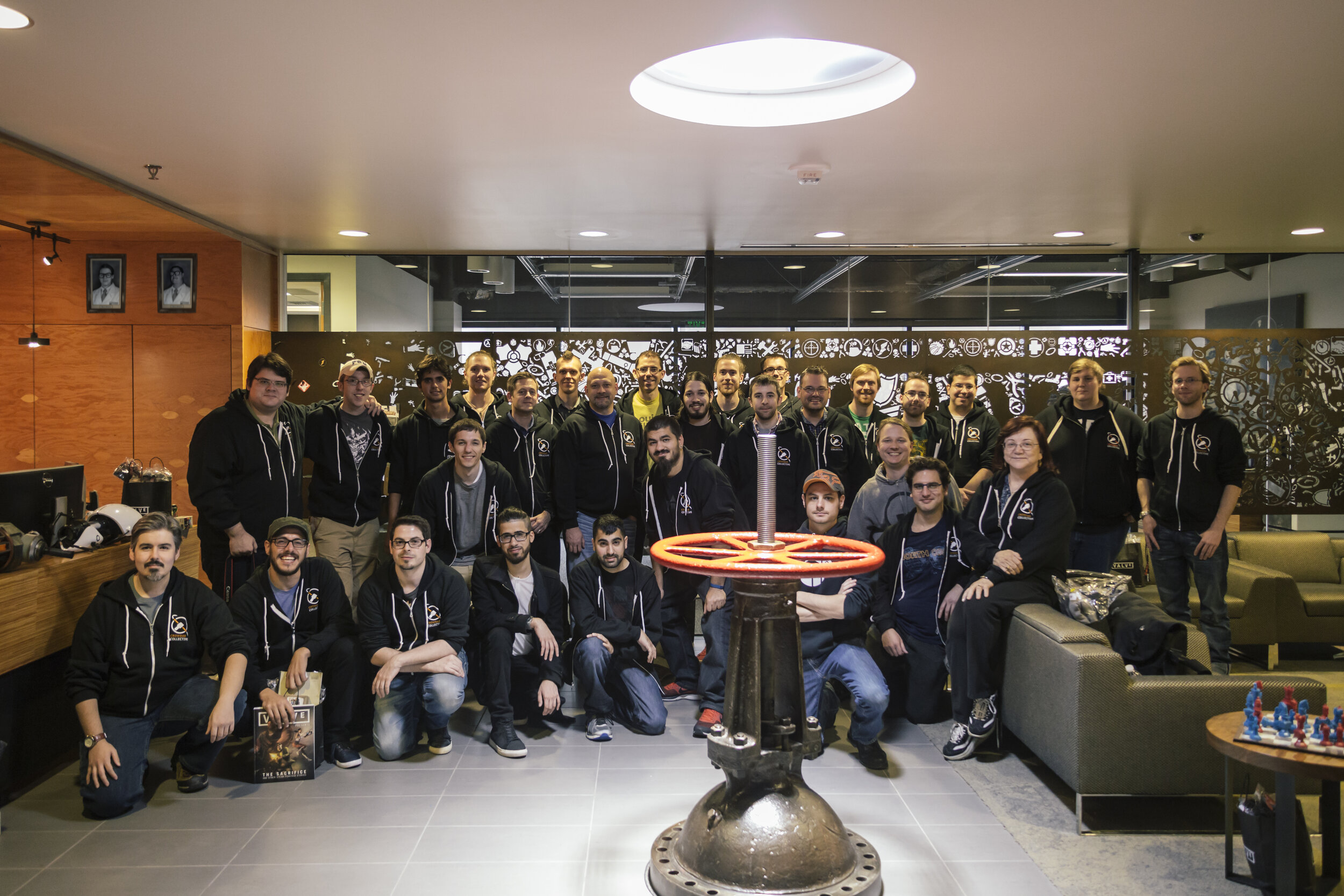Black Mesa 1.0 came out on March 6 bringing closure to 16 years of arguably the most ambitious modding effort ever. The nuances of Gordon Freeman’s inaugural adventure cleverly rewritten, multiple environments and AI overhauled, Xen completely reimagined. The game itself, once a fan mod, is now a commercial stand-alone title. All good things to those who wait.
As Crowbar Collective, the team behind the project, is recovering from the shock of the release, we catch up with Black Mesa project lead Adam Engels.
Adam Engels, Black Mesa Project Lead
Oleg Nesterenko, managing editor at GWO: Adam, all these years, you’ve been a virtual distributed studio with lots of people on board from every part of the world. How do you manage such a team?
We are currently at about 20 part time and per contract developers. Over the years we had about 50 volunteer developers. For most of development we relied on a dev forum where we communicated, organized tasks, and posted works in progress for feedback. Forums were a bit dated, even back when we released the Earthbound chapters in 2012, but they gave us a good way to pool our information and work across the world in multiple different time zones.
Our communication is one of the big successes of the team. The feeling of isolation is real. It makes it really important to talk to other developers and post your work. Knowing other people are in the trenches with you is one of the keys to staying motivated on a decentralized project.
As we progressed, we got more and more organized, and now are using a three part system of Discord, Google Docs, and Trello.
How did you go about acquiring new talent?
We were really lucky and had enough reach to get new people fairly easily. Coders were hard to get as the engine became more and more dated, and we did put out a couple of job ads later in the project, but for the most part we were able to get people by them coming to us, or by word of mouth.
When Valve allowed you to start selling the game in 2013, did they make any expertise available to you?
With the Source licence, you get access to source files so that you can build code (or things like animation libraries). We worked with Valve to set up the company and the game on Steam, but other than that we have not utilized their expertise at all. Our insights into the original intent is only what we can glean from articles, and books like Raising the Bar.
Crowbar Collective visiting Valve headquarters in 2015
Speaking of Source, what was your experience with the tech?
Source is a great engine. If you want to build a shooter in an urban or interior environment, it is perfect. That may sound like a backhanded compliment, but just look at the projects that have come out of Source. It really lets people focus on their ideas and designs rather than having to block out the base engine first.
It is definitely a house of cards though after years of updates and improvements. Things that take months to implement in the Source engine, only take weeks (or less) in a modern engine. Getting art assets into the game is a nightmare, and if you want to see ANY lighting change, it takes a multi hour compile of the level. We are also running into some real issues with being on DirectX 9. We could get a lot more features and performance, but we are locked to a very old version of DirectX, and porting would be a huge amount of work.
What about the work with the community? Was there more pressure or more inspiration in it?
I wouldn’t really say there was more of one than the other. The pressure can inspire you, and with inspiration came the pressure to make the game live up to the series. We knew we could not charge money for something, then not finish it, and we really wanted to finish the game regardless. A lot of the comments we received were along the lines of: “Take your time, make it right,” which is what converted the pressure into motivation. It’s pretty easy to look at the mountain of work it takes to complete any project and get overwhelming anxiety, but comments like that really help quell that fear. The positive comments really helped us put the metaphorical pen to paper.
It must have been quite a journey for you. Graduating from being a Half-Life fan to actually working on the franchise. How did your perception of Half-Life change when you started poking under its hood as a developer?
It took me a long time to figure out what made Half-Life stand out to me, and to figure out what made it one of my favorite games. It is set apart from any other titles in the FPS genre by its elaborate world building, and connected linear story. Starting with the Inbound tram ride, the setting is established and Black Mesa feels like a real facility. Nothing has gone horribly wrong yet (apart from a myriad of OSHA violations). There are no bad guys, you are not enroute to cleaning up someone else’s mess; it is just a normal day at work in the sprawling Black Mesa complex.
From there you, the player, cause the inciting incident. You, the player, travel through a series of CONNECTED levels to the game’s climax. This is something few games in the genre do to this day. It is massively important to connect the player to the world and give them a reason to care about the outcome of the story.
What about the game’s weaknesses?
A lot of the weaknesses of Half-Life were fixed in the new Source engine. The shooting and movement were greatly improved (or maybe “modernized” would be a better term), and we just had to utilize it and tweak it to reflect the original Half-Life. The first game being dated (even by 2004 standards) required us to extrapolate or make up large sections of architecture or machinery to make the world feel more realistic, and to fit the standards of the new engine. We expanded on parts we felt were too simple, and cut out parts that felt dated or confusing.
Then there is Xen, which I think we can all safely say we underestimated. It is one thing to say “Xen was not my favorite part of Half-Life” and another thing to say “OK how do we make Xen better?”
To figure it out, you had to learn from Half-Life 2.
The strength of Half-Life 2 was its massive evolution in design. It is also a notable jump in technology. I distinctly remember being blown away by the graphics presentations Valve was putting on before release.
I think for its time, Half-Life 2 represents about as close to a perfect game as you can get. There wasn’t much they could do better with the tech at the time.
One of the biggest challenges we had sticking to the Half-Life 2/Valve philosophy was not having cutscenes or tutorials. Got a cool game idea? OK how do you teach it to the player without breaking the 4th wall, and in the Xen chapters, without someone telling you how to use it?
You said you tried to stick to Half-Life 2/Valve game design philosophy.
Yeah. Our guiding rule was “How would Valve make Half-Life if they made it today.”
What are the pillars of that philosophy?
Valve themselves may have a different take on it, but OUR interpretation is you introduce a mechanic to the player, you teach them how to use it, then you test them on using it.
A simple example of this is right at the start of Xen. We had to account for someone loading straight into the chapter, so we first have you long jump over a gap that, if you miss, you fall safely into the water below. That is the introduction. We then teach them how to use the long jump over a series of very easy jumps that are clearly signposted as “Here’s where you go next.” We then have the player make a very long jump onto a floating rock with no safety net, to test that they understand the core mechanic before they can move on and get to more and more advanced long jumping.
They [Valve] are also not afraid to get a bit gamey with their mechanics. An example I like to use is in Episode 2, when you are driving around in the buggy from derelict house to derelict house fighting Hunters. They needed a way to tell the player “Hey you’re done here, move on” so they flash the buggy’s headlights on and off when you have accomplished your objective in that area. In the context of “realism” that makes no sense, but in the context of a game, it is critical to keeping the pace moving.
You obviously tried to bridge the narrative and technological gap between Half-Life 1 and 2. But you also referenced Portal’s long fall boots in Black Mesa. Are you going to throw something in from Half-Life: Alyx with a later patch? Have you played it?
As of writing this I am about 6 hours into the game. We don’t have any plans for tie-ins with Alyx.
We put the Portal boots in as a head nod to the other series, and because Aperture was around when Black Mesa was, and could have got a government contract for high agility boots for special forces.
If it hasn’t already been 16 years, would you want to reimagine the original game even further?
Probably not. We had a ton of interesting ideas, and some large sections of levels that we cut. What we really learned from making the Xen levels is if it does not compliment or add to the core design of the game, then it is probably better left on the cutting room floor. Quality over quantity.
Sounds like Xen didn’t come easy to you. It’s just four chapters out of eighteen, but it took you around the same time to complete as the the rest of the game. Was figuring out your own Xen the biggest challenge of the entire development process?
Yes by far. Making the Earthbound levels, even when we were making new sections, we at least had some reference of real world objects. Xen had to be our own creation. Other than some science gear, we couldn’t use ANY of the assets we already created for the Earthbound levels. We had to figure out the design, figure out the art, and we quite frankly didn’t know where to start. In the end we created roughly 4 distinct biomes across 21 maps, and about 5 hours of new gameplay.
For your next project, you are moving on to a new IP. But will you be also doing something different in terms of game design philosophy?
Nope, not really. The broader approach is to have everything support the core loop of the game’s design. A beautiful game with bad gameplay is going to feel bad. A great story in a game with bad gameplay is going to feel bad. Everything has to feed into the pillars of the game. You obviously have to take time, and make compromises for art and technology, but in the world of video games, the core design should come first. This is what Valve’s philosophy does for their games, and it can be adapted to a wide variety of game designs.
Adam, thank you for your time and good luck to Crowbar Collective. Looking forward to your next move.







